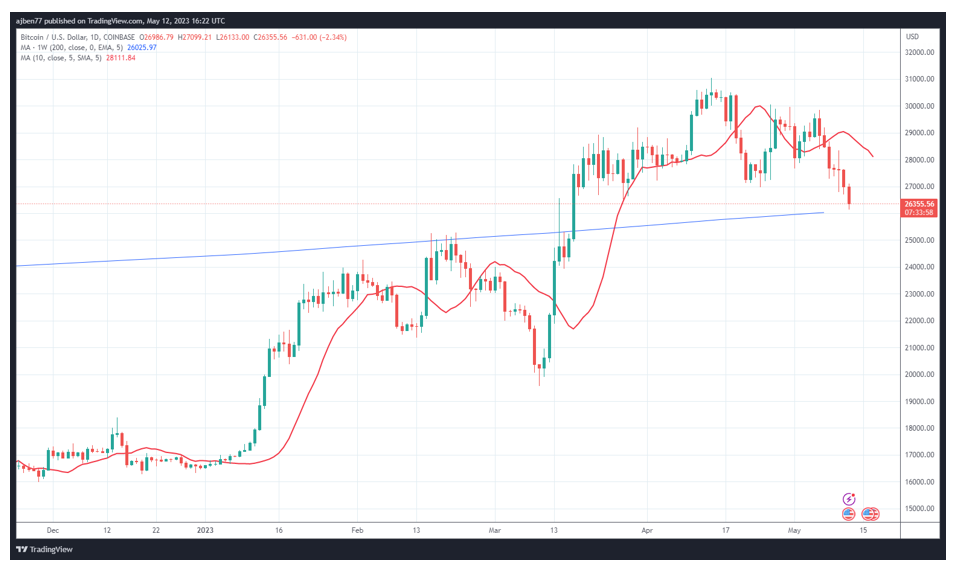Banking Woes and the Power of the Printing Press
 |
| By Juan Villaverde & Alex Benfield |
Even Hollywood would struggle to dream up this recent financial plot twist: The Federal Reserve reported that a staggering 722 U.S. banks have lost over half their capital.
To add to these worries, 30 of these institutions have taken a nosedive into negative equity … essentially declaring themselves bankrupt.
This scenario is reminiscent of a disastrous game of Monopoly, where everyone is landing on a hotel-laden Boardwalk.
Earlier in the year, warnings of the potential failure of Silicon Valley Bank were presented to the Fed. Unfortunately, these alerts were shrugged off.
Fast-forward a few weeks, and the grim prophecy came true: Silicon Valley Bank collapsed in March. That sounded the opening bell for what is now ominously being referred to as the “Banking Crisis of 2023.”
However, despite this alarming report suggesting more bank failures could be on the horizon, the Fed continues to project a picture of stability.
Meanwhile, some market commentators are playing a dangerous game of denial. In fact, they are even applauding the “strong balance sheets” of certain institutions and attributing a 50% drop in PacWest’s (PACW) stock to a market glitch.
Let's not forget, though, that banking essentially runs on confidence. When that starts to crumble, the whole building is bound to cave in.
Combine eroding confidence with record losses on bond portfolios and Federal Reserve policies draining away deposits, and you've got yourself a recipe for a full-scale financial panic.
This recipe for disaster could be a wake-up call for all financial markets, which have been snoozing in complacency for far too long. And yes, even the ever-volatile crypto market could be in for a rude awakening.
A few weeks ago, we discussed the near-perfect 97% correlation between global central bank balance sheets and Nasdaq performance. For crypto, that correlation stands at around 86%.
Simply put, when the central banks' money printers are in full swing, asset prices tend to climb. And this pattern played out perfectly in recent events.
Last October, as China eased its monetary policy, Bitcoin (BTC, “A-”) and the stock market enjoyed a boost. A few months later, the Bank of Japan joined the money printing party, resulting in a surge in both crypto and stock prices.
However, the printing presses took a break in February 2023. What followed was a slump in Bitcoin's value.
Then came March, when U.S. banks started teetering on the brink. At that time, the Fed fired up its printing presses, leading to another rally in Bitcoin.
Currently, we are in a quieter phase with central banks playing the waiting game.
But don't be fooled by the lull. The financial puppet masters are simply biding their time, waiting for the perfect moment to hit the “print” button again.
Despite the Fed’s reassurances, there's a storm brewing on the horizon. You see, rumors are circulating that the U.S. Treasury could run out of money as early as June.
So, the fact that the markets have been relatively calm recently doesn’t mean you should be, too.
When the storm finally hits, we are likely to see a flood of freshly printed dollars. And that could be just the adrenaline shot that crypto needs to surge once again.
In the meantime, keep your eyes on the horizon and your fingers on your digital wallets.
And we don’t know about you, but Alex is definitely looking forward to when the Fed resumes its long-established track record of money printing its way out of problems.
However, between now and then, we may see some volatility and weakness in the crypto markets.
And in that time, you may want to look for other ways to find opportunity in the crypto market. To that end, we want to draw your attention to our colleague Chris Coney. He’s developed a strategy to go for DeFi yields in any market.
With it, his most conservative position is yielding double what you can expect from junk bonds and 54 times what you could expect from the average bank money market account!
You can learn more about this exciting strategy by watching Chris’ Superyield Conference. We suggest you do so before we take it offline.
Now, it’s time to turn to recent price action. Over the past few weeks, Bitcoin has struggled a bit after failing to establish itself above that key $30,000 level.
It has fallen for a solid seven days straight after its last attempt to get over that mark and is now retesting its 200-week moving average near the $26,000 level. If that 200-week MA support doesn’t hold, Bitcoin’s next target would be the February high of $25,000.
We’ll be looking to see if and where BTC can find support and turn things around over the next few days. If BTC can find its footing, we would expect another attempt to break that $30,000 mark.
Currently, there appears to be two ways the short-term price action can play out:
1. Bitcoin finds support soon and attempts one more rally in the coming weeks. BTC should attempt to break $30,000 again and, if successful, it could make a run for $40,000.
2. Bitcoin loses support and retests the previous range near $23,000. This would set a lower low, which would set us up for a few months of neutral price action.
It’s too early to tell what might happen just yet. But either way, the recent bullish trend is likely to end sometime in the coming weeks.
The only question is whether there remains one more rally to sell into before we return to neutral market conditions.
Although the Fed’s money printing will help bring liquidity to the crypto market, there’s no telling exactly when that liquidity will arrive.
The Fed has been tougher on rate hikes and quantitative tightening than most analysts predicted. So, it wouldn’t be too shocking if it holds tight for a few more months despite further weakness in the economy and banking sector.
At the end of the day, though, Juan is right: The money printer will once again pump liquidity back into risk assets.
But for now, it’s a waiting game.
Best,
Juan & Alex


